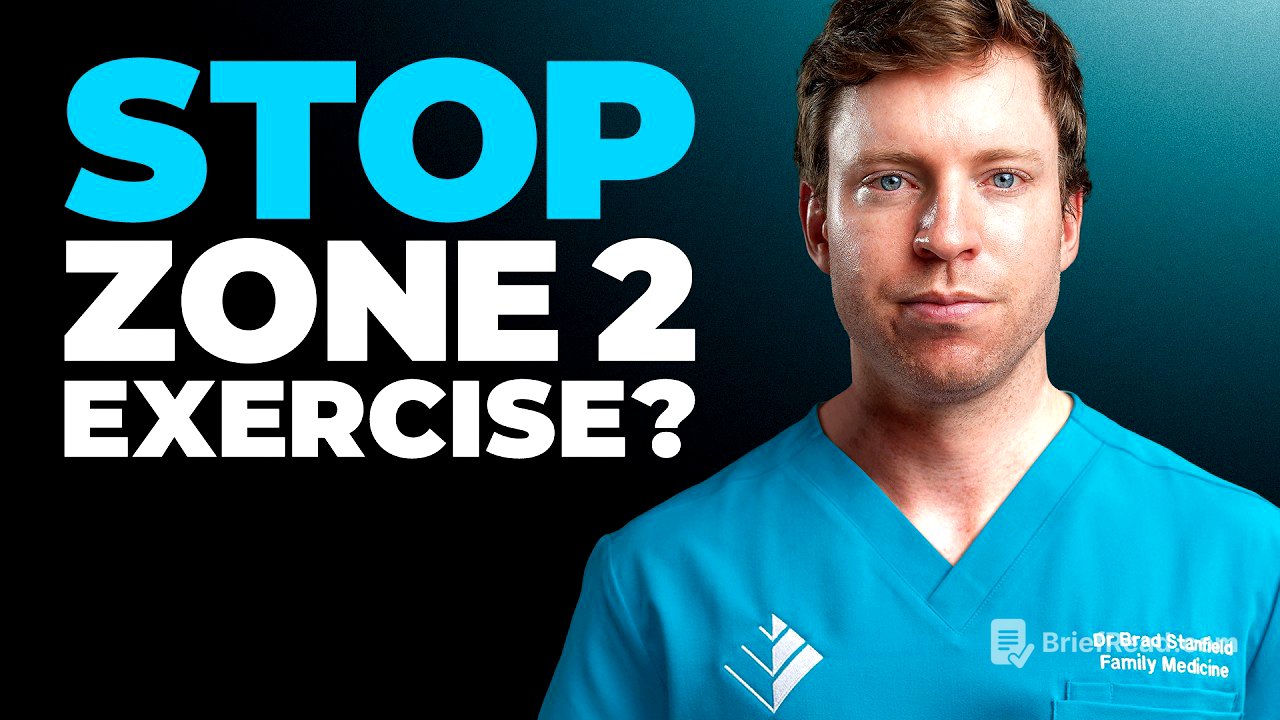TLDR;
This video challenges the popular notion that Zone 2 training is the optimal intensity for improving mitochondrial and fatty acid oxidative capacity. It argues that while Zone 2 training has benefits, especially for elite athletes who can dedicate a lot of time to it, high-intensity exercise may be more effective for non-elite athletes with limited time. The video emphasizes the importance of high-intensity exercise for cardiorespiratory fitness and overall health.
- Zone 2 training may not be the most effective way to improve mitochondrial health or fatty acid oxidation for non-elite athletes.
- High-intensity exercise is crucial for cardiorespiratory fitness and overall health.
- Prioritize high-intensity exercise if you have limited time to work out.
Are We Wrong About Zone 2 Training? [0:00]
The video starts by questioning the widely accepted benefits of Zone 2 training, particularly after a new analysis suggested it might not be the optimal intensity for improving mitochondrial or fatty acid oxidative capacity. Voices like Dr. Peter Attia have promoted Zone 2 training as a sweet spot for exercise, leading to the question of whether it should be a priority over other forms of exercise. The video aims to explore this controversy by examining the research and explaining what Zone 2 training is and why it's considered helpful.
What is Zone 2 Training (in plain English)? [0:36]
Zone 2 training is a way to describe exercise intensity. Peter Attia defines it as the level of exercise sustainable while keeping lactate levels below 2 millimoles per liter. Lactate is a byproduct of energy production in muscles, and its buildup leads to fatigue. In Zone 2, the goal is to maintain an intensity where the body can clear lactate as it's produced, allowing for sustained exercise. A simpler way to gauge Zone 2 is the "talk test," where you can comfortably hold a conversation while working out.
Two Big Promises of Zone 2 Training [1:29]
Zone 2 training is believed to provide the greatest benefits in two key areas: mitochondrial capacity and fatty acid oxidative capacity. Mitochondrial capacity refers to the health and function of mitochondria, the powerhouses of our cells, which are crucial for metabolic health, athletic performance, and even the aging process. Fatty acid oxidation capacity describes how well our bodies can convert fat stores into energy, which is linked to better athletic performance, heart health, and insulin responses. Exercise, in general, is known to boost both mitochondrial health and fatty acid oxidation capacity.
Zone 2 Controversy & The New Study [3:04]
The controversy arises when considering what type of exercise is best for gaining these benefits. The new analysis questions the hype around Zone 2 training. A common argument is that elite athletes do large volumes of Zone 2 training and have great mitochondrial health and fatty acid oxidation capacity, suggesting that copying their training strategy might be beneficial. However, the authors of the analysis point out that elite athletes also incorporate high-intensity exercise, making it unclear which type of training is more important. Additionally, most people aren't elite athletes and may not have the time to dedicate to the extensive Zone 2 training that elite athletes do.
Is Zone 2 Best for Mitochondrial Health? [4:02]
The analysis questions whether Zone 2 training is truly the best for mitochondrial health. When we exercise, we stimulate our muscles, signaling the body to strengthen our exercise capacity by creating new mitochondria. The authors of the analysis examined research on various signaling pathways and found minimal or non-existent activation with Zone 2 training. For example, mitochondria can be stimulated by strain on cellular energy systems, but Zone 2 training provides minimal stress to these systems. While elite athletes doing a lot of Zone 2 training may see changes, those who don't dedicate as much time might see minimal changes. A meta-analysis showed that for non-endurance trained individuals, Zone 2 intensity didn't seem to improve mitochondrial function, while exercise above Zone 2 did.
Is Zone 2 Best for Fatty Acid Oxidation Capacity? [6:50]
There are limited studies directly addressing the impact of Zone 2 training on fatty acid oxidation capacity. The review authors found only one study that measured fatty acid oxidation rates after repeated Zone 2 training, which showed a significant increase in the maximum fat oxidation rate during exercise after one year. Other studies are difficult to interpret because they didn't always check participants' lactate levels to confirm they were actually exercising in Zone 2. Studies comparing different intensity levels have conflicting results, with some showing greater benefits from lower intensity exercise and others showing superior results from high-intensity exercise. A recent meta-analysis found that both high-intensity and moderate-intensity training improved fat oxidation similarly.
The Verdict on Zone 2 for Non-Elite Athletes [8:32]
For non-elite athletes, the claimed benefits of Zone 2 exercise are questionable. It doesn't appear to be more effective in stimulating mitochondrial health, and it certainly doesn't seem to have a bigger impact on fatty acid oxidation capacity. In fact, the evidence suggests that higher intensities may be more helpful for mitochondrial changes. This has practical implications because Zone 2 exercise can easily take up the limited time that non-elite athletes have for exercise, potentially overshadowing the greater benefits of high-intensity exercise.
The Importance of High Intensity Exercise [9:08]
High-intensity exercise has a much bigger payoff when it comes to health, particularly in relation to mitochondrial function and cardiorespiratory fitness. Cardiorespiratory fitness, measured by VO2 max, is strongly linked to health outcomes. Studies have shown that individuals with better VO2 max scores have a significantly lower mortality risk. Improving cardiorespiratory fitness is a good target, and the data favors higher intensity exercise for a more significant impact in this area, especially for non-elite athletes with limited time.
Key Takeaways and Conclusions [10:19]
If you're not an elite athlete and have limited time for exercise, focus your energy on activities that provide the biggest payoff. Spending the majority of your time in Zone 2 may cause you to miss out on significant gains achievable at higher intensities. The advice is to focus on high-intensity exercise done safely, building up slowly to avoid injury. Aim for at least 75 minutes of vigorous intensity exercise a week, and if you have time beyond that, consider adding in some Zone 2 training. Even minimal amounts of exercise can make a difference, so focus on the right kinds of movements to achieve massive payoffs.









